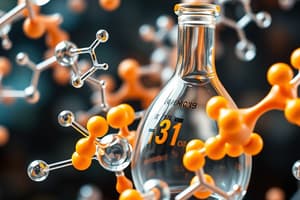Podcast
Questions and Answers
What is the primary function of enzymes within the cell?
What is the primary function of enzymes within the cell?
- To accelerate chemical reactions (correct)
- To provide structural support for the cell
- To regulate cell division
- To store genetic information
How do enzymes achieve their specificity in catalyzing reactions?
How do enzymes achieve their specificity in catalyzing reactions?
- By releasing energy during the reaction process
- By storing the necessary substrates for reactions
- By providing structural support for the reactants
- By being the correct shape and chemical composition for specific reactions (correct)
What determines the unique shape and function of a protein?
What determines the unique shape and function of a protein?
- The specific order of amino acids in the protein (correct)
- The presence of complex carbohydrates in its structure
- The type of cell in which it is found
- The number of peptide bonds it contains
In what way are proteins different from enzymes?
In what way are proteins different from enzymes?
What is the primary structure of a protein?
What is the primary structure of a protein?
What is the function of hemoglobin?
What is the function of hemoglobin?
Where does protein synthesis occur?
Where does protein synthesis occur?
What is the role of enzymes in biochemical reactions?
What is the role of enzymes in biochemical reactions?
How do enzymes interact with proteins to regulate reactions?
How do enzymes interact with proteins to regulate reactions?
Which stage involves the copying of the DNA blueprint into mRNA?
Which stage involves the copying of the DNA blueprint into mRNA?
Which equation represents the reaction rate based on enzyme kinetics?
Which equation represents the reaction rate based on enzyme kinetics?
At what substrate concentration is the Michaelis constant equal to half the maximum reaction rate?
At what substrate concentration is the Michaelis constant equal to half the maximum reaction rate?
Which level of protein structure involves global folding into a compact three-dimensional shape?
Which level of protein structure involves global folding into a compact three-dimensional shape?
What are proteins made up of?
What are proteins made up of?
Which type of protein facilitates the movement of molecules across cell membranes?
Which type of protein facilitates the movement of molecules across cell membranes?
What is the quaternary structure of a protein composed of?
What is the quaternary structure of a protein composed of?
Which class of proteins catalyze biochemical reactions?
Which class of proteins catalyze biochemical reactions?
What is the role of enzymes in sustaining life?
What is the role of enzymes in sustaining life?
Which type of proteins modulate the activity of other proteins?
Which type of proteins modulate the activity of other proteins?
In what way do enzymes contribute to regulating metabolic pathways?
In what way do enzymes contribute to regulating metabolic pathways?
Study Notes
Biological Chemistry: A Deep Dive into Enzymes, Protein Structure, and Proteins
Biological Chemistry, a multidisciplinary field, focuses on the study of chemical substances and processes that occur in plants, animals, and microorganisms. It delves into understanding the chemistry of life, drawing on techniques from analytical, organic, and physical chemistry, as well as the molecular basis of vital processes. In this article, we will explore the subtopics of enzymes, protein structure, and proteins to gain a deeper understanding of Biological Chemistry.
Enzymes
Enzymes are organic catalysts that accelerate chemical reactions within the cell, often by lowering the activation energy required for a reaction to occur. They play a vital role in the metabolic processes of all living organisms. Enzymes are highly specific and can only catalyze reactions for which they are the correct shape and chemical composition.
For instance, consider the enzyme amylase, which breaks down complex carbohydrates like starch into simpler sugars. Amylase's shape and chemical properties are tailored to fit the structure of starch, allowing it to shear the polysaccharide into smaller units with ease.
Protein Structure
Proteins are made up of amino acids, which are linked together by peptide bonds. The specific order of amino acids in a protein determines its unique shape and function. Proteins have multiple levels of organization:
- Primary Structure: The linear sequence of amino acids in the polypeptide chain.
- Secondary Structure: The folding and arrangement of the peptide backbone into regular patterns, such as alpha-helices and beta-sheets.
- Tertiary Structure: The overall three-dimensional shape of the protein, resulting from the interactions between amino acid side chains.
- Quaternary Structure: The association of multiple polypeptide chains, also known as subunits, to form a functional protein complex.
Proteins
Proteins play a multitude of roles in the biological world, such as:
- Catalysts: Enzymes are proteins that catalyze biochemical reactions.
- Structural Components: Proteins like collagen provide structural support in tissues and organs.
- Transport Proteins: Hemoglobin, a protein, transports oxygen in the blood.
- Regulatory Proteins: Proteins like receptors and transcription factors control cellular processes.
Protein synthesis occurs in two stages:
- Transcription: The DNA blueprint for a protein is copied into a molecule of messenger RNA (mRNA) in the nucleus.
- Translation: The mRNA moves out of the nucleus into the cytoplasm, where it is read by ribosomes to synthesize the protein.
Interaction Between Enzymes and Proteins
Enzymes often interact with proteins to ensure that biochemical reactions occur at the right time and place. Enzymes can be inhibited by other proteins to regulate the rate of a reaction. Inhibition can occur through competitive, non-competitive, or allosteric mechanisms.
In summary, Biological Chemistry focuses on the chemical processes occurring in living organisms, with enzymes and proteins playing pivotal roles in maintaining life's intricate balance. Understanding enzyme structure, protein synthesis, and protein function is essential to comprehend the complexity of life.
Studying That Suits You
Use AI to generate personalized quizzes and flashcards to suit your learning preferences.
Description
Test your knowledge of enzymes, protein structure, and proteins in Biological Chemistry. Explore topics such as the role of enzymes as catalysts, the levels of protein structure, protein functions, and the interaction between enzymes and proteins.




